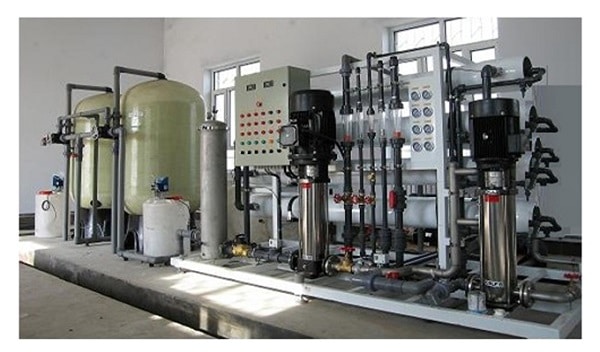Before getting into detail about how reverse osmosis plant works, let us focus on what this plant is for. The reverse osmosis plant is a manufacturing unit that allows the process of reverse osmosis. It is to purify water as it goes through the osmosis membrane to equalise the presence of the particles. The treatment technique reverses the osmosis method, where the solution passes through two outlets: the filtered water goes one way, and the impure water goes the other way.
Let us look into the functioning of a reverse osmosis plant and filtration process that gives safe water.
Basic Steps of Reverse Osmosis Plant
- An RO system will remove chlorine and sediment from water using a prefilter in the pretreatment stage before the water passes through a semi-permeable membrane.
- Here, it will remove the solids and other contaminants from the water.
- After water comes out from the RO membrane, it will go through a postfilter that will polish the water before it goes into another faucet.
This shows the number of filtration stages that reverse osmosis includes.
How Many Stages Are There in a RO Plant?
In the reverse osmosis system, the RO membrane is an integral component. It has other filtration stages as well, resulting in pure drinking water. The RO water system has a carbon and a sediment filter along with an RO membrane. These are either the prefilters or postfilter, depending on the stage when the water will pass through it.
Each system has more than one filter, and they are:
- Carbon filter – It reduces the VOC or volatile organic compound, chlorine, and other contaminants that contribute to odour or waster taste.
- Sediment filter – It can eliminate particles like dirt, dust, or rust.
- Semi-permeable membrane – It can effectively remove TDS or total dissolved salts.
However, the final steps of the RO Plant include the following:
- After water enters the RO Plant, it goes through prefiltration. It includes a sediment filter and carbon filter that helps remove chlorine and sediment that might damage the RO membrane.
- Then, water goes through the membrane that can remove even microscopic particles.
- After the filtration, water goes to the storage tank for storage. The RO Plant continues and stores water in the tank until it is full.
- As you turn on the drinking faucet, water starts to come from the storage tank through another filter to ensure polish and safe drinking water.
What Happens in Reverse Osmosis?
A high-pressure pump increases the pressure on salt particles in an RO to force the water through a semi-permeable membrane. It has the potency to remove almost 95% of the salts in the stream, resulting in clean water. However, the salt concentration decides the pressure required. The higher the concentration of the water, the more the osmotic pressure.
After the demineralising process, the product is the permeated water. The water contaminants will go through the reject stream. Now, the feed water will pass through the membrane without the salt and contaminants. It goes to the drain or is suitable to send it back to the water supply. In some cases, there is recycling of the water using the RO system to save and ensure the highest quality.
This shows how RO includes cross-filtration, where the contaminants are stored in a filter media. The water passes through two outlets. The efficient filtration will help water to avoid contaminants build up, keeping the membrane clean to give safe and clean water.
Factors Influencing the Function of RO Plant
Several calculations influence the performance of the RO Plant. Some parameters need to be at the minimum level, and they are:
- Feed flow
- Permeate pressure
- Feed pressure
- Concentrate pressure
- Permeate flow
- Permeate conductivity
- Feed conductivity
- Temperature
It also depends on the design of a RO Plant. These are vital for the efficient functioning of RO Plants for industrial projects. It can also impact the output water and its purity.
What Includes in the Pretreatment Stage?
The pretreatment stage is crucial, and it includes chemical and mechanical treatments. It can prevent scaling, fouling and membrane failure. This step necessitates frequent cleaning of the filters to ensure top-quality resultant water. The pretreatment often influences the ultimate cost of an RO system.
Is Reverse Osmosis Bio-Friendly?
After using water, it drains out from your home. It contains chemicals, contaminants, and other particles. It is important to remove the particles before recycling the water. Here, the wastewater is sent to the water treatment plant or goes through dilution to treat it easily before it goes to the riverbeds. Here, the reverse osmosis process helps run an efficient waste treatment.
An efficient reverse osmosis plant can speed up the water cycling process as there are no chemicals in the water when RO water drains from a home water system. The filtration process helps remove chemical particles and bacteria from water. It can also desalinate seawater and is perfect for use in the medical field. It results in a pure form of water that can prevent any waterborne disease.
With a suitable idea of how the RO Plant works, investing in a robust system would be beneficial. Invest in the latest and highest-quality Doctor Fresh RO plant. It ensures quality and safe drinking water at the best market rates. From installation to ease of maintaining the RO plant, our specialists can assist you with timely service.




